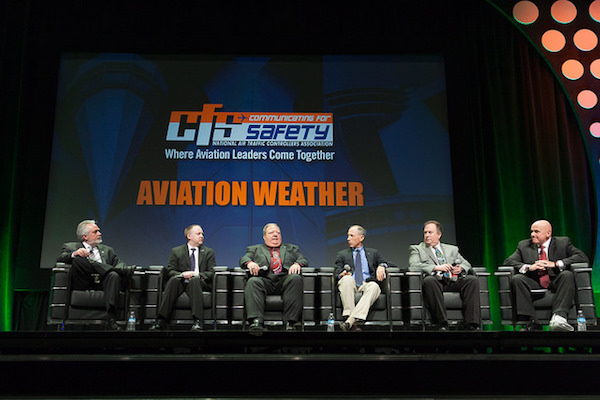
June 3, 2016 // Communicating For Safety 2016 Panel: Aviation Weather
 |
| From left to right: Ullmann, Cabak, and Schilz. |
Moderators:
Jim Ullmann, Deputy Director, Safety and Technology, NATCA
Terry Biggio, Vice President, Safety and Technical Training, FAA
Panelists:
Matt Tucker, National Weather Representative, NATCA
Bruce Landsberg, Senior Safety Advisor, AOPA
Mike Schilz, Safety Information Analysis Program, ALPA
Matt Cabak, Safety Focal, SUPCOM, ATO
Overview:
FAA Air Traffic Organization (ATO) Chief Operating Officer Teri Bristol, in opening the panel, said despite the advancements and updates happening throughout the aviation community, weather has remained a constant challenge.
“Seventy-five percent of all weather-related accidents are fatal,” she said. “We have the opportunity to make a big difference and save lives on a daily basis.”
Ullmann and Biggio stressed how important communication between controllers and pilots is when it comes to weather. In fact, a majority of Archie League Medal of Safety Award-nominated events are related to weather.
“Neither the pilot nor the controller have all the information and we need to work together to complete the picture for the pilots so they can make a decision based on all available information,” said Ullmann.
Discussing what can be done to minimize weather related accidents is a priority for everyone operating within the National Airspace System (NAS). Schilz described that one issue is that weather information pilots receive before takeoff can be up to three hours old, saying, “It is important to fill the gap between what pilots have access to and what controllers have access to.”
 |
| From left to right: Landsberg, Tucker, and Biggio. |
With a large portion of the workforce retiring in the air traffic controller and pilot communities, it is more important than ever to be aware of the range of experience on the ground and in the air.
“We must establish an appropriate level of communication,” Landsberg said. “Asking questions can make a huge difference in preventing accidents.”
Tucker explained how NextGen technologies could be used to help fill that gap. When dealing with weather, the most up-to-date information is power. “The goal is to have it embedded in automation,” he said.
Air traffic controllers can assist pilots by reaching out and giving guidance. Panelists agreed that a well-placed question could make all of the difference.
“We need to take it upon ourselves,” said Cabak. “We need to take the opportunity to peer coach. There is a wealth of knowledge at this conference that you now possess. It is incumbent upon you to share it with a new generation.”
The panelists also discussed the importance of voluntary safety reporting in improving how weather events are handled. Collecting information and data, sharing that information, and using it for training within NATCA and the FAA will allow us to learn from weather-related experiences and prevent dangerous situations from happening again.
Panelists also revealed a new weather awareness campaign, “Take a Stand for Safety: Weather, Complete the Picture,” created by the FAA and NATCA.


